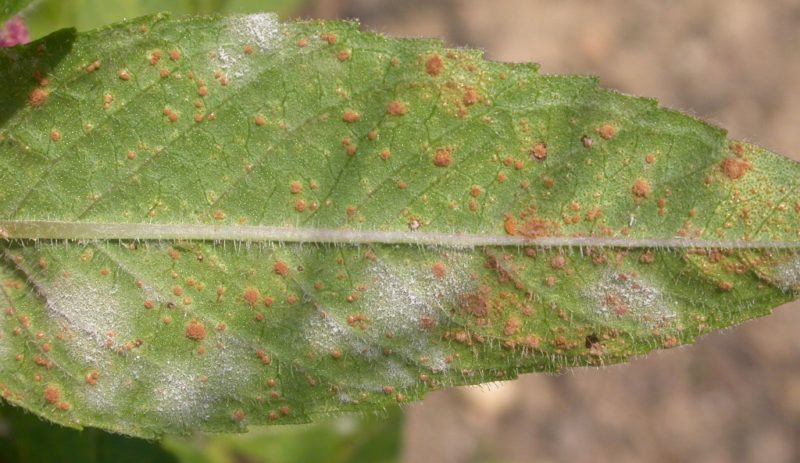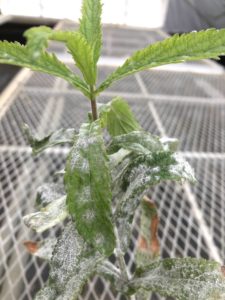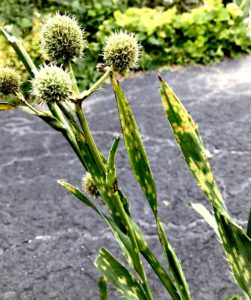
Perennial Problems with Mildew, Rust and White Smut
Herbaceous perennials are thought of as rough and tough once out in the garden, but when brought together in large groupings of one species in a greenhouse or nursery, they can be especially vulnerable to certain diseases. Fortunately, many of the pathogens are host-specific, so that problems are usually limited to one kind of plant. This article will give you an idea of the powdery mildew, rust and white smut diseases to expect, and how to counteract them.
POWDERY MILDEW
Growing herbaceous perennials often means growing powdery mildew as well. This group of fungal plant parasites is irritatingly conspicuous, causing white spots called “colonies” or coating plants with a thin growth of fungus strands so they look gray instead of green. Unlike other diseases, with powdery mildew you can see the fungus because it grows along the plant surface, inserting tiny haustoria (structures for nutrient and moisture absorption).
The fungus spores (conidia) are in long chains projecting out from the leaf, stem or petal surface. Conidia are often produced in great abundance and they are moved about by air currents, so a powdery mildew can spread quickly within a production area when the environmental conditions are just right.

The main drivers of powdery mildew are temperature and moisture. Excess moisture favors the parasites of the parasites — fungi such as Ampelomyces quisqualis that prey upon powdery mildews thrive under wet conditions, whereas the powdery mildew fungi themselves are most favored by high humidity rather than outright wetness. Because of their sensitivity to environmental conditions, powdery mildew problems fluctuate in seriousness from one year to the next. They tend to be problematic primarily in late summer and fall.
White colonies of powdery mildew are usually easy to identify. But be forewarned that sometimes the fungus will be only on the undersurface of leaves. If you are growing a plant you know is prone to powdery mildew, turn leaves over if you see any spotting, just to make sure. Chlorotic (yellow) spots or purplish areas sometimes show on the top of a leaf when white colonies are growing on the undersurface.
The powdery mildew disease most often misidentified is the one on sedum, which forms brown scabby spots on the leaves. The fungus in this case is injuring the tissue more than it does ordinarily, so you will need to look closely with a hand lens or a dissecting microscope to see the whitish strands of fungus growing across the scabby spots. Sometimes the fungus forms water-soaked spots on the back of sedum leaves, looking more bacterial than fungal.
The crops most inclined to powdery mildew include delphinium, helianthemum, monarda, peony, phlox, sedum and scabiosa. As a first line of defense, investigate whether you can find cultivars to grow that are less susceptible. Popular Phlox paniculata used to be extremely prone to mildew but shifts in growers’ cultivar choices appear to have much reduced the problem. Among whites, for example, phlox ‘David’ is far less susceptible than phlox ‘Mount Fuji’.
For powdery mildew control, look to potassium bicarbonate, chlorothalonil and biocontrols containing Bacillus or Streptomyces as surface-acting protectants that will keep minor problems in check. If a serious problem with a powdery mildew arises, look to fungicides in FRAC Group 11 (strobilurin) and FRAC Group 3 (DMI) categories for the benefit of systemic action.
Fungicides in FRAC Group 11, 3, 11 + 3 or 11 +7 can be rotated with contact-action protectants for a strong management program. See labels for details on whether materials are labeled for greenhouse, nursery or landscape use, which crops can be treated, and how many times a material can be used before rotating to another FRAC Group.
RUST
Rust diseases look quite different from powdery mildews, but they also are caused by fungi, and they are similar enough that generally the same fungicides work on both diseases. As with powdery mildew, rust fungi can be seen on the surface of the plant — at least their spores are external, poised for dissemination by wind or water. Rust spores are held in clumps referred to as rust “pustules” that are found mostly on the undersurface of leaves. They often come in eye-catching colors, in a range of hues from white to yellow to orange to rusty brown to chocolate brown or black.
Rusts are not as common as powdery mildews, but you probably grow a few perennials that are susceptible. Heuchera has a rust with tan spore pustules, Puccinia heucherae, which can affect other members of the Saxifrage family as well (e.g., saxifraga, tellima, tiarella, tolmiea). Goldenrod often shows a rust that is yellow-orange; veronica may show dark chocolate brown pustules.
Growers of Panicum virgatum may have noticed leaf spots that sporulate in pustules when examined closely; for this host Uromyces graminicola and Puccinia spp. are known as pathogens in the U.S. Rusts are also seen commonly on monarda. A rust with brown sporulation (Puccinia chrysanthemi) and another with white cushion-like spore pustules (P. horiana) are seen occasionally on chrysanthemums; chrysanthemum white rust is subject to federal quarantine.
Perhaps the most famous of rust diseases on perennials is daylily rust, which happens to affect two different herbaceous perennials: Hemerocallis and Patrinia. The “repeating” stage is on daylily, so Patrinia is not essential for the disease to perpetuate itself. Recently we saw a rust on soft rush, Juncus effusus, a wetland plant that is used for restoration — and to make tatami mats in Japan. The widespread rust Uromyces junci-effusi has its “repeating” and overwintering stages on the rush — and no alternate host is known.
Rusts are sensitive to some contact materials including neem oil and mancozebs, and to systemic materials in FRAC groups 11 and 3, similarly to powdery mildews. Reducing leaf wetness duration helps with rust control.
In some cases, there may be an opportunity to eliminate an alternate host which is essential for the rust’s lifecycle, but often it seems that the lifecycle allows repeated infection on the crop without need for an alternate host (as for the rush rust described above). In other cases, the alternate host for a herbaceous

spots due to white smut
(Entyloma ho-chunkii)
infection.
perennial may be a tree (some of the goldenrod rusts have pine trees as alternate hosts).
WHITE SMUT
White smuts, caused by Entyloma species, are less-familiar relatives of rusts. White smut on dahlia (E. dahliae) and gaillardia (E. polysporum) are two of the more common of these diseases. Both show leaf spots, whitish to pale green, and the spots eventually turn tan to brown as they mature. The pathogens must be identified by examining sporulation inside the brown leaf lesions with a microscope. This past year a distinctive white smut pathogen, E. ho-chunkii, came to light in the Midwest and Northeast, appearing on Eryngium yuccifolium. The symptoms begin as small, veinbounded, bright yellow spots, turning brown with time.
Fungicide labels do not usually mention white smuts. Plants being treated with fungicides that control rust will probably have reduced white smut symptoms, but you may need to rely on sanitation (prompt and careful disposal of infected plants) to keep this disease from becoming a problem in production. White smuts are known to be seedborne in some cases, and spores can overwinter in plant debris. It’s important to clean up thoroughly after an outbreak!


 Video Library
Video Library 




















